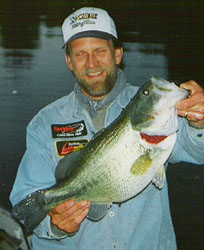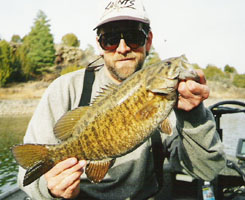"JERKBAITS + WATER = MONSTER BASS"
By Gregg Munck
When you're searching for larger than average size bass, increase
your odds by using the correct tools. Jerkbaits are an extremely versatile
lure, and they have the attributes that interest any bass that swims.
Floating, suspending, and countdown models are available in many different
styles, sizes, shapes, and colors. Then you have to decide if rattles
are required. So how do you pick the right lure?
 Quite a few aspects come into play when I'm choosing a lure. Certainly
water temperatures are a consideration you should be aware of. In
general, when water temperatures are 60 degrees and climbing, I
will tie on
a floating minnowbait. The bass are more aggressive and willing to
chase after a lure with an erratic presentation. When you locate
fish at a specific depth, where they are either holding on structure,
or
possibly suspended, a countdown model can be a good choice. Most
countdown lures will sink approximately one foot per second.
Quite a few aspects come into play when I'm choosing a lure. Certainly
water temperatures are a consideration you should be aware of. In
general, when water temperatures are 60 degrees and climbing, I
will tie on
a floating minnowbait. The bass are more aggressive and willing to
chase after a lure with an erratic presentation. When you locate
fish at a specific depth, where they are either holding on structure,
or
possibly suspended, a countdown model can be a good choice. Most
countdown lures will sink approximately one foot per second.
When water temperatures range between the
low 40's and the low 50's that is when I reach for my suspending lures.
While fishing
during
colder water temperatures, it's important to make adjustments in
your presentation. Bass are cold blooded, and they become lethargic
in the
colder water so when you pause or stop a jerkbait right in their
face, it often gives them the additional time to decide if they
want your
offering. Sometimes a long pause will encourage a strike. Other
times a sharp twitch or two will create a reaction strike. At times
a stop
and go retrieve can be effective. As you try different presentations,
the
fish will clue you in to what their preference is on a given
day.
 It is common for a bass to follow a jerkbait
all the way to the boat. Next time this situation occurs,
try these tips. First and foremost, make sure you have a good pair
of polarized sunglasses
so you can
spot
the followers
a good distance from the boat. Try changing the angle of your
rod tip, which will affect your lures presentation. At times
changing
the color
of your lure can be productive. On occasion, I abruptly kill
my retrieve, followed by a sharp twitch of the rod tip, to create a
strike. Short rod sweeps
of approximately
two to three feet can draw interest to your offering. And
there is always the option of down sizing your lure to entice a
follower into a hookup. Basically, you're giving these veteran fish
something
new to look at that they haven't seen before.
I can tell you, from my years of experience on the water
that all
monster
smallies, and largemouth bass love to gobble jerkbaits
up. I always have a follow up lure rigged and ready, like a
senko or fluke to throw in immediately after a strike. Here is
a short list
of jerbait
manufacturer's which have performed well for me while pursuing
trophy bass through the years, and they are: Bomber, Smithwick,
Rapala,
Strike King, Luckycraft, Yo-Zuri, and Rebel.
It is common for a bass to follow a jerkbait
all the way to the boat. Next time this situation occurs,
try these tips. First and foremost, make sure you have a good pair
of polarized sunglasses
so you can
spot
the followers
a good distance from the boat. Try changing the angle of your
rod tip, which will affect your lures presentation. At times
changing
the color
of your lure can be productive. On occasion, I abruptly kill
my retrieve, followed by a sharp twitch of the rod tip, to create a
strike. Short rod sweeps
of approximately
two to three feet can draw interest to your offering. And
there is always the option of down sizing your lure to entice a
follower into a hookup. Basically, you're giving these veteran fish
something
new to look at that they haven't seen before.
I can tell you, from my years of experience on the water
that all
monster
smallies, and largemouth bass love to gobble jerkbaits
up. I always have a follow up lure rigged and ready, like a
senko or fluke to throw in immediately after a strike. Here is
a short list
of jerbait
manufacturer's which have performed well for me while pursuing
trophy bass through the years, and they are: Bomber, Smithwick,
Rapala,
Strike King, Luckycraft, Yo-Zuri, and Rebel.
Even today, with all the improvement's lure
manufacturers have made in their production process, and quality control
procedures,
identical
lures can vary in weight and balance right out of the
box. Many suspending models will rise slowly in the water column.
To check
your lures,
simply tie them on and toss them out if you're on a clear
lake and observe
how they react. You can also check the 1ures in a swimming
pool, bathtub or a sink. There are products available
so you can add weight to your lures. Sticky weight, suspendots, and
suspenstrips are easy to apply and remove
if necessary. Various water temperatures will certainly affect a suspending
lure's buoyancy. In colder water, your jerkbaits will require more
weight to make it suspend properly. I alter the majority of the lures
I fish with to some extent. I believe subtle details make the difference
between hooking a toad and going home empty handed.
Water clarity should also be addressed when you are choosing a stickbait.
I require at least a couple feet of visibility when selecting a jerkbait
for my lure of choice. I believe veteran fish become interested in
your jerkbait because of the visual attraction. When you twitch the
plug, the flash signals to a predator that there is wounded prey in
the vicinity. Once this occurs, then natural instincts take over and
the bass will often commit to a reaction strike.
When fishing jerks in stained water, the color of the plug you choose
becomes an issue. A firetiger or clown pattern would make a good
choice because of the bright chartreuse, orange, and red, which
helps the
fish locate the offering. This is also a good time to upgrade the
size of the lure you're using. A larger jerkbait will give off
more
vibration especially when rattles are included as a feature.
Throughout the country, as well as in Arizona, Game and
Fish departments have regular stocking schedules. If the body of water
you plan
to fish has been stocked with shad or rainbow trout, you can't
go wrong
when
selecting a jerkbait with a dark back, and a light belly.
The Southwestern United States is known for its clear water
lakes and reservoirs. When you're faced with cold front conditions,
highly pressured
lakes, and crystal clear reservoirs, there are ways to adapt.
Using a jerkbait under these situations, the first thing I do is
down
size my lures. Next I choose the most natural colors available
in shad
and crawdad patterns. When fishing with the smaller baits, I
breakout the
spinning tackle spooled with fluorocarbon eight pound test line.
In certain situations, I will drop down to six pound test line.
The spinning
tackle and lighter line help with casting issues, and also affords
you the opportunity to work these smaller baits with a more natural
looking presentation.
Balancing your rod and reel with the correct line and lure is
extremely important in my opinion, especially when working
jerkbaits for
trophy bass. When you get all the right tools together, it
makes the job
of catching monster bass so much easier.
For more information about Gregg Munck, just visit his website. http://www.munckstrophyfishing.com
Gregg Munck Bio

